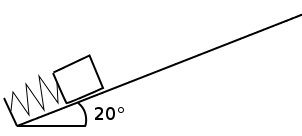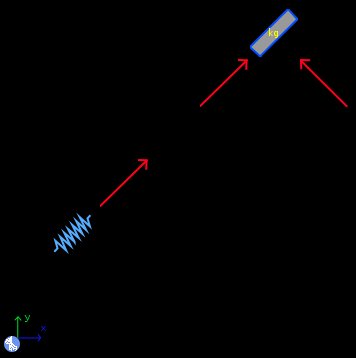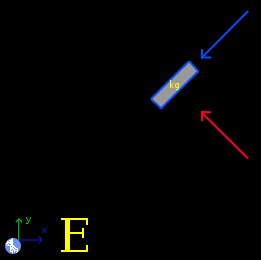Next: Example 5, Previous: Example 3, Up: Examples dynamics of particles [Contents][Index]
11.4 Example 4
A block of 2 kilograms of mass is above a spring with a constant of 1100 N/m that is stretched 5 cm, as show the image. The dynamic friction coefficient between the block and the plane is 0.2. If the spring is released suddenly, and the friction force acts from which the block leaves the spring, Which distance travelled the block above the plane? Without the 5 cm that the spring is stretched. How much energy is lost through friction?

Solution with FisicaLab
Erase the content of the chalkboard and select the SI system. And add one element Stationary reference system, one element Block above an inclined plane to the left and one element Spring. And add the necessary elements Force to make the free body diagram of block and the spring. As show the image below:

Remember that the forces applied to a spring must be in the direction which will move the spring.
We need solve the problem in two steps. First we need know the velocity of the block when leaves the spring. And after applied a friction force to know the travelled distance. To first step, in the element Stationary reference system write:
- g
9.81
- t
t
Because time data is unknown. To the spring:
- Name
Spring
- k
1100
- xi
-5 @ cm
- xf
0
Here the name is irrelevant. The initial position is negative because the spring is stretched. And final position is 0. To the force applied to the spring, that is an unknown data, write:
- f
f
- ang
20
Here the angle is irrelevant. To the block:
- Name
Block
- m
2
- ang
20
- a
a
- vi
0
- vf
vf
- d
5 @ cm
- Relative to
sf
The travelled distance is the longitude that the spring is stretched. To the force that correspond with the normal, that is a 70 degrees, write:
- f
n
- ang
70
And to the force applied to the spring, write:
- f
f
- ang
20
Now click in the icon Solve to get the answer:
n = 18.437 N ; f = 27.500 N ; t = 0.098 s ; a = 10.395 m/s2 ; vf = 1.020 m/s ; Status = success.
The acceleration data is the average acceleration, because the force isn’t constant. The force is the average force too.
Now, to the second step, delete the spring and its forces. And add one element Energy and one element Friction, as show the image below:

The data in the element Stationary reference system is the same:
- g
9.81
- t
t
Now, to the block write:
- Name
Block
- m
2
- ang
20
- a
a
- vi
1.020
- vf
0
- d
d
- Relative to
sf
Now the name to this element is important. The initial velocity is the velocity calculated in the first step. And the end velocity is 0. Also, the distance travelled is now an unknown data. To the normal force the data is the same:
- f
n
- ang
70
To the element Friction write:
- Normal
n
- u
0.2
Where n is the normal to calculate the friction force. And to the element Energy:
- Object 1
Block
- Object 2
0
- Object 3
0
- Object 4
0
- W
Work
Now click in the icon Solve to get the answer:
n = 18.437 N ; a = -5.199 m/s2 ; d = 0.100 m ; t = 0.196 s ; Work = -0.369 J ; Status = success. WARNING: Check that the sense of friction forces is opposite of the movement sense (when correspond).
The lost energy is 0.369 Joules, and the travelled distance is 0.100 meters or 10 cm.